How Does the Draw Wire Sensor Work?
Have you ever found yourself thinking where these machines get the decision to stop and how do they quantify distance? Well, this is where draw wire sensors do come in. In this article of SOP, we will be discussing how the DRAW WIRE SENSOR function, the benefits of the draw wire sensors, what is new in draw wire sensors, and Safe usage of draw wire sensors.

What Is A Draw Wire Sensor?
A draw wire sensor by SOP is a linear utilized sensor in documenting movements and distances in a given environment. It is also referred to as the string potentiometer, the cable displacement, or the string encoder. Measurement of displacement is done through a wire or cable and a method of converting the displacement of an object into an electrical one.
Advantages of Draw Wire Sensors
Technological improvements of draw wire sensors offer some benefits. First of all, they are extremely accurate, dependable and resistant to wear and tears to withstand the conditions of an industrial setting. The submitted ones are resistant to temperatures, humidity as well as vibrations. Second, they span for a very long time and this implies that they don’t need frequent replacement or major corrective measures. Thirdly, they are cheaper because they can be used in different ways, given their good efficiency.
Innovation of Draw Wire Sensors
Other improvements that can be done on sensors, particularly draw wire sensors include; In recent years advancements have been made in the manner in which draw wire sensors work, how accurate they are, and how durable they are. They now have digital displays for the reading of the results, wireless capability for transmission of data and enhanced measuring spans. Some 10-100000mm Pull Rope Draw Wire Displacement Sensor WPS-XS can furthermore measure angles and rotations of the Knick point thus, they are used for more complex tasks.
Safety and Use of Draw Wire Sensors
They are non-intrusive and risk-free as far as they are applied in conformity with the manufacturing guidelines. They are made to be tamper proof the cables can also be configured for measurement varying by different applications. They also include safeguard aspects such as overload since overloading the sensor can cause a lot of harm.
How to Use Draw Wire Sensors
For it is easy to understand how to apply draw wire sensors The usage of draw wire sensors is easy as they are normally employed in the following way. Firstly, you have to connect the wire or cable for the object which you want to measure. Regarding the issue of mounting, you can apply brackets, clips, and screws for holding the structure. Once the 10-100000mm Pull Rope Draw Wire Displacement Sensor WPS-S is connected, proper tension should be ensured in order for it to work as required. This is so since length of the wire has a bearing on the measurements made Many users of this chemical end up losing a lot of money due to having to constantly replace torn wires. Lastly, you require to interface the sensor with a data acquisition system which will act as a converter and will turn the electrical signal into a usable form.
Draw Wire Sensor Service and Quality
As for maintenance, draw wire sensors are low-maintenance instruments for which it is necessary to calibrate them periodically to increase reliability and accuracy. This also prevents the development of problems that would eventually hinder its operation, for instance, through the help of routine calibration. When buying draw wire sensors, many factors should be considered most importantly the manufacturers hence, one should go to business with reputable manufactures of quality products and efficient customer services. This means that when you intend to spend your money, you get the best, and your sensors afford to give their best.
Applications of Draw Wire Sensors
Therefore draw wire sensors can be implied in different every sector of the economy like the automotive sector, aerospace, mechanical industries, robotics, and industrial automation among others. They are applied for measuring strokes of some parts of the car like pistons, cylinders, doors and other extra load measuring mechanisms. They are also incorporated in safety applications like the bumper switch as well as the seat belt switch.
 EN
EN
 AR
AR HR
HR CS
CS DA
DA FI
FI FR
FR DE
DE EL
EL HI
HI IT
IT JA
JA NO
NO PL
PL PT
PT RO
RO RU
RU ES
ES SV
SV IW
IW ID
ID LV
LV LT
LT SR
SR SK
SK SL
SL UK
UK VI
VI ET
ET HU
HU TH
TH TR
TR FA
FA AF
AF KA
KA UR
UR BN
BN